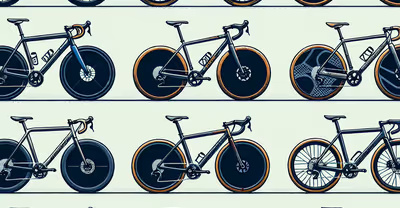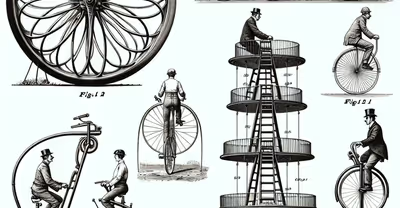
Key Takeaways
- Bicycles are considered vehicles and cyclists must adhere to the same rules and regulations as drivers when riding.
- All 50 states legally classify bikes as vehicles, with bike laws varying in each municipality.
- Cyclists who violate traffic laws will be issued tickets and face the same consequences as car drivers.
- Bike riders should be aware of cyclists' rights and must follow all traffic laws to ensure their own safety, as well as the safety of pedestrians and drivers on the road.
- To encourage bicycle safety, riders must wear helmets, reflectors, and lights, stop at traffic lights, and observe all posted signage when riding.
The legality of riding a bicycle often comes into question, with many cyclists wondering whether a bike is officially considered a vehicle.
Yes, bicycles are considered vehicles according to traffic law, and they must follow the same rules as other vehicles on the road. Bicycles can achieve speeds that exceed those of pedestrians and can even match the speeds of cars in certain speed limit zones, posing potential dangers and hazards.
When it comes to providing reliable information on bicycles, I pride myself on staying informed and up-to-date on relevant laws and regulations. My passion and expertise in cycling ensure that you can trust the information shared in this article, allowing you to make better decisions when riding your bike to avoid legal complications.
Understanding Bicycles and Vehicles
In this section, we'll explore the relationship between bicycles and vehicles. Understanding the legal differences between these modes of transport is essential to adhere to traffic laws.
Definition of a Vehicle
By definition, a vehicle is any machine that transports people or cargo from one place to another. This broad definition includes various modes of transportation such as cars, buses, trucks, trains, and even (some) non-motorized vehicles. To be considered a vehicle, the mode of transportation must meet the primary function of ferrying people or cargo.
Legal Classification of Bicycles
According to traffic law, bicycles are considered vehicles. Despite being non-motorized, bicycles are still legally classified as vehicles given that they can transport a person from one location to another.
Essentially, a bicycle is a self-propelled device with two or more wheels, pedals, and a steering mechanism. However, bicycles can differ from motor vehicles in terms of some of the traffic laws and regulations they must follow.
For example, cyclists are generally required to ride on the right-hand side of the road and follow specific road signs and speed limits. These rules are in place to protect cyclists, pedestrians, and drivers.
A bicycle's functionality and architecture categorize it as a vehicle. Sharing similarities in transportation capabilities with buses, trucks, and trains, bicycles enable users to efficiently move themselves and their cargo from one place to another.
Legal Complications of Bicycles
Bicycles, as vehicles, also abide by the same laws and penalties that apply to motor vehicles. Consequently, a cyclist caught violating traffic laws may face tickets and points against their driver's license, if they possess one.
This can become particularly problematic given that there are a lot of inconsistencies regarding cycling laws. This is often dependent on the location where you are cycling, especially where laws have not been clearly laid out.
To avoid potential legal complications when riding, you should always look into the specific laws of your region.
Legal Perspectives of Bicycle Riding
As I began looking into the legality of riding a bicycle, I discovered that laws can often vary from state to state, as well as on a federal level. In addition, there are also international laws that need to be considered if you decide to ride your bike abroad.
Let's delve into federal and state laws and international differences.
State Laws
The biggest difference between state and federal laws regarding bike riding is that some states have specific laws that dictate where bicycles can and can’t be ridden.
In the United States, most states regard bicycles as "vehicles." However, some states classify them as "like a vehicle," creating ambiguities in legal interpretations. State-specific examples, like Illinois, demonstrate inconsistencies, as it excludes human-powered machines from the definition of "vehicle." This results in different legal interpretations when accidents or violations occur.
Arkansas and North Carolina have equitable laws for cyclists and car drivers. This implies that the same laws apply to both cyclists and drivers, which is much more straightforward than in most states.
The bottom line is that rules tend to vary among states and municipalities. For instance, HG.org points out that bicycles are usually allowed to use sidewalks alongside pedestrians unless signs dictate otherwise, with specific rules differing across locations.
Federal Laws
The federal stance on bike riding is pretty relaxed and the government allows bikes to be ridden on most roads. There are sometimes restrictions regarding highways and some federal lands such as national parks.
Cylists’ rights are historic in the United States, and people have contested restrictions on bike riding since the 1800s. These days, the federal government leaves most of the bike laws up to the states and does not impose serious laws against cyclists.
International Laws
Internationally, the classification of bicycles as vehicles may vary. This is due to different legal frameworks in place in various countries.
For instance, Bicycles Stack Exchange provides historical perspective on UK laws, where bicycles and similar machines were declared carriages in the era of horse-drawn carts.
In any case, ever since the advent of automobiles, bicycles continue to be considered vehicles in many parts of the world. However, it's crucial to stay informed about different regulations as they tend to change depending on where you ride your bicycle.
Rights and Responsibilities on the Road
As cyclists, it's important to understand our rights and responsibilities on the road to ensure a safe journey for ourselves and others. Let's explore cyclists' rights and responsibilities to gain a clear perspective on how a bicycle is considered a vehicle.
Bicyclists' Rights
It's essential to know that in all 50 states, bicycles are either regarded as vehicles or have the same rights and responsibilities as motor vehicle operators. Therefore, when we ride our bikes on the road, we are considered road users, just like cars and motorbikes.
According to the American Automobile Association (AAA), once you dismount and walk alongside your bicycle, you are considered a pedestrian with the same rights as other pedestrians. It's essential to remember that we have the right to use the road, but we also have to respect and share the road with everyone else.
Road Rules and Compliance
Riding a bicycle on the street entails the necessary compliance with traffic rules, including observing all traffic signs, signaling turns, and having safety features like helmets, reflectors, and lights.
Bicycles are treated much the same as cars while on the street. Consequently, it is our responsibility to familiarize ourselves with traffic laws and to follow them diligently.
Besides following the general traffic laws, there are specific guidelines designed for bicyclists. For example, bicyclists should wear approved helmets, reduce speed and exercise caution when riding on pedestrian facilities, avoid weaving in and out of parked cars, and move off the street to stop, park, or make repairs to their bicycles.
Safety Considerations
When discussing whether a bicycle is considered a vehicle, it's essential to consider safety factors that impact both cyclists and other road users.
Shared Road Etiquette & Safety Equipment
One critical aspect of safely sharing the road is understanding and following the rules. All states require bicyclists on the roadway to follow the same rules and responsibilities as motorists.
As a cyclist, it's crucial to be aware of traffic signs and to use hand signals when turning. This promotes predictability and communication with other motorists on the road.
Additionally, certain safety features are also mandatory for every bicycle rider to ensure safe cycling, such as:
- Helmets
- Reflectors
- Lights
It is necessary for motorists to remember that they share the road with bicycles, and to be respectful and cautious when driving in close proximity. Giving bicycles enough space when passing and being aware of their presence on the road are key components of shared road etiquette.
That said, cyclists are also obliged to give drivers the same level of awareness when sharing the road. This helps prevent accidents and it also encourages a better relationship between drivers and cyclists.
Bicycle Infrastructure
Safe cycling heavily depends on appropriate infrastructure that separates bicycles from traffic, minimizing conflicts and accidents. Examples of such infrastructure are bike lanes and dedicated bike paths.
Investing in bicycle infrastructure helps promote the safe and efficient coexistence of bicycles and motor vehicles on the roads, ensuring that all modes of transportation can navigate the streets safely.
Bike Lanes
Bike lanes provide a designated space for bicycles on the road, usually marked by painted lines or other physical barriers. Riding in a bike lane encourages orderly traffic flow and separates bicycles from larger vehicles, reducing the risk of accidents.
In some cities, protected bike lanes offer additional safety with physical barriers, such as bollards or raised curbs. Bike lanes generally move in the same direction as traffic and have the same traffic laws as for other cars on the road.
Bike Paths
Dedicated bicycle paths, on the other hand, offer a separate network of pathways for bicycles. These paths are often removed from roads and are designed specifically for bicycle and pedestrian travel.
These paths provide a safer environment for bicycle riders because they don't interact with motor vehicle traffic directly. Well-structured urban planning incorporates bike paths as a key part of the infrastructure.
With a sophisticated network of bike paths, cyclists can enjoy riding without constantly being around cars and they reduce the risk of accidents.




















































































































































































































































































































































































































































































































































































































































































































































.avif)
